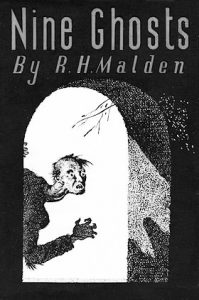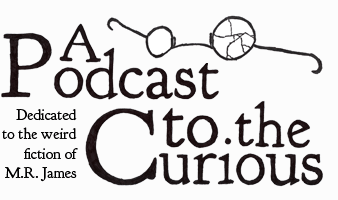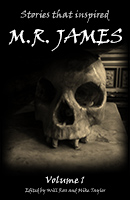 This Halloween Mike and Will stroll out into the garden to take a look at The Sundial by R.H. Malden. But who is that lurking in the bushes?
This Halloween Mike and Will stroll out into the garden to take a look at The Sundial by R.H. Malden. But who is that lurking in the bushes?
Thanks to Kirsty for providing excellent readings for this episode!
Show notes:
- Nine Ghosts by R.H. Malden (Project Gutenberg Australia)
Malden only wrote one volume of ghost stories, and it is available to read in its entirety on the Project Gutenberg Australia website. - R.H Malden (Ghosts and Scholars)
This G&S article by Richard Johnson provides some biographical details about Malden, as well as some commentary on his stories. More biographical information can be found at Wikipedia. - Scrinia Reserata (Google Books)
In the introduction Malden tells us that the manuscript that makes up most of The Sundial was found tucked inside a copy of this book, a biography of Archbishop John Williams. - The Rose Garden by M.R. James (Wikisource)
It is hard to discuss The Sundial without repeatedly coming back to its clear inspiration, The Rose Garden by M.R. James. - Why were people who died by suicide historically buried at crossroads? (HistoryExtra.com)
This brief article explores the history of crossroad burials, as well as touching on the publics changing attitude towards suicide as a result of the death of Lord Castlereagh. - Croxton, Cambridgeshire (Google Maps)
The unnamed author omits the location where The Sundial takes place, but provides enough small details throughout the story to fairly confidently identify Croxton Park in Cambridgeshire as the most likely real-world location. As with the house in the story, Croxton Park is 60 miles north of London, and close to a mainline railway station. The house was built around the same time mentioned in the story, and has the site of a medieval hamlet within its grounds. In the story the house lies between the villages of ‘Abbotsley’ and ‘Farley’. Croxton Park is bordered by Abbotsholme to the south west and Eltisley to the east. See here and here for more details on the history of the house and park, including historical maps. - Nightjars (Legendary Dartmoor)
There are many superstitions concerning Nightjars (or Goatsuckers, as they are sometimes called!). This is likely due to their nocturnal habits and unusual cry. - Sundial mottoes (wikipedia)
Malden doesn’t explain the exact motto that the narrator puts on his sundial, but this list of sundial mottoes will give you a flavour of the sort of thing that adorned ornamental sundials of the period. - Spirits of Solomon (Fandom Demopedia wiki)
At the conclusion of the story Parker, the ex-sergeant of marines and butler, purchases a picture of ‘King Solomon issuing directions to a corvée of demons‘. It is most likely a version of the picture in this article, which also list all 72 of the spirits/demons that King Solomon was said to have commanded!
Podcast: Play in new window | Download
Subscribe: RSS
Tags: Nine Ghosts, R.H. Malden, The Sundial








Maybe the copy of Scrinia Reserata had belonged to James, and the ms. was one of his unpublished stories.
Croxton commits suicide on 31 October 1578, and seems to reach the height of his haunting prowess on 31 October 1900ish – another spook considerate enough to observe the switch to the Gregorian calendar. I suppose as a Catholic he had to.
There was a sundial in an exhibit of Renaissance scientific instruments at the Metropolitan Museum in New York last year. One of the Latin inscriptions on it was “Thou shalt seek me in the morning and I shall not be.”
Minus points for not using ‘psychopomp’ when discussing the night-jars.
“Minus points for not using ‘psychopomp’ when discussing the night-jars.”
One of my Top Ten words. Right up there with ‘omphalos.’
Well lads you did it – a Halloween themed ghost story dropped on Halloween! A delightful listen whilst walking through woods as the day heads towards sunset on this celebration of Samhain. I liked the Jamesian influence but Malden is no M.R. The ending was jarring and I would have preferred something less blunt – but it was enjoyably spooky up to that point. Mike, you should copyright “BendyMan” though I think “The Lurking Yokel” is the horror franchise we didn’t realize we needed. Have a Happy Halloween and look forward to the next one!
Thank you!
Very happy to see this Halloween present pop up on the site!
This is the only Malden story I’ve read, and it’s not exactly a promising start, but you’ve made me just curious enough to check out another. He’s no James, to be sure, the story’s actually pretty awkward, it’s very blunt and tonally inconsistent, going from antiquarian ghost story to occult detective story, giving it a really unsatisfying ending. I don’t necessarily mind those stories once you don’t take them as ghostly-themed thrillers and not stories intended to unsettle. There’s no real mood building throughout, either, he just inserts the odd creepy event with little weight, he never really lingers.
I read it just last night so I hadn’t really gone over it or anything, but yeah, his overt reference to ‘The Rose Garden’ is, and I hate to say this, very fanboyish. I’d almost say like August Derleth if I wanted to be really mean, but I won’t, because I think Malden actually meant well here. But still, it’s nonsensical compared to the rest of the story and seems to exist to just for James fans. And I personally found the chase sequence quite comical. If it was meant to be dreamlike and surreal, it didn’t come across for me. I actually chuckled when he decided to just rush the ghost. I also have no idea what that ending with the King Solomon engraving was about.
But for all that, something rubbed off on Malden right because there’s two really good moments in here that felt like they came from James. The first is where he says ‘Once I could have almost sworn my door was cautiously opened and closed again.’ That’s really unsettling. There’s an intelligence to it, it’s very deliberate. I know a lot has been made of bedroom horror and sexuality, but there’s really nowhere you’re more vulnerable than your bed, asleep and defenseless. The second was the description of the ghost before the chase, and how the body slides out of the darkness, that’s just really strange and a good visual.
Outstanding! I couldn’t have asked for a better discussion of this story and its author. From the readings, to the analysis, to the detective work… really well done!
I agree with your assessment that Malden’s ghost stories evoke a nicely comfortable feeling in the reader, despite their ab-natural subject matter; also, that this story could have used a bit less Flaxman Low (or perhaps a bit more, given the hilarious “no house left unburnt” policy you correctly ascribe to him). For what it’s worth, the other eight stories in the collection don’t feature much of this ghost detective business.
Of those stories, I find myself returning to The Dining-room Fireplace (which has similar body-horror elements as The Sundial) and The Priest’s Brass (only partly because it has a character with the awesome name of Nicholas Clenchwarton).
One thing that strikes me when re-reading Nine Ghosts is the vividness of Malden’s imagery. Every story has a visually rich “wallop,” from The Sundial’s Bendy-Neck Croxton to the towering apparition who runs over the narrator in Between Sunset and Moonrise. His memorably weird descriptions remind me of the works of Inklings member Charles Williams; The Place of the Lion, for example.
I rate this episode 10 ghosts out of 9 (with one extra for finding the actual haunted house).
Since you asked so nicely for our “reckons,” here is my stab at The Sundial, aided greatly by your own analysis. I’m making two assumptions here: (1) that Malden’s ghosts don’t necessarily follow the same rules as those of James, and (2) that the Rector may not be the expert on ghost safety he believes himself to be.
Malden seems to be experimenting with the idea of boundary violation as a source of horror. Croxton’s crossroads grave is encroached upon and annexed by the first Lord Rye (possibly dispelling any crossroads-related imprisoning magic thereby); the grave is threatened with destruction by the unnamed tenant; and Croxton retaliates by invading the tenant’s garden, dreams, and personal space.
Rector aside, I suspect that Croxton would have eventually killed the unnamed tenant, considering his successful murders of previous residents (at least that’s how I interpret the talk of “troubles” from the neighborhood elders).
The sound like the harsh call of a nightjar that is heard during the lair’s unearthing might indeed be a reference to eastern whip-poor-wills and their famed roles as psychopomps, but it seems more likely that Malden’s bird is the European nightjar. These birds have a very different call than their North American cousins, sounding somewhat like a creaky door slowly opening (or like the death rattle of an expiring revenant).
Finally, I regard the “If you’ll pull, I’ll push” line as being in the context of Croxton’s overall program to terrify the tenant, rather than a plea for the stake to be uprooted. (This is perhaps the most disturbing boundary violation of all, as it could be interpreted as a very crude pick-up line.) The tenant is in no way enticed by the suggestion, but is horrified, and it seems to me that Bendy Croxton is banking on this reaction.
Just my two cents! Thanks again for this episode, I really enjoyed it.
Just had to comment to say it’s great to have another episode of the podcast! I’ve been working my way through your back catalogue at intervals on my walks through this strange year – lovely bit of me time after a day either working at home or toddler-wrangling!
Can I request that you cover some LTC Rolt in future episodes? His tales have genuinely scared me at times – I had Bosworth Summit Pound stuck unpleasantly in my head for quite some time after I first read it. The whole book Sleep No More is excellent (and aptly titled)
We will do! We have Bosworth Summit Pound bookmarked for that. I am trying to convince Will to record it with me on a canal boat for added atmosphere
In 1969, film director John Landis (The Blues Brothers) was working as a production assistant on the film Kelly’s Heroes, which was shot on location in Yugoslavia. Several members of the crew were travelling by truck at night when they passed a group of gypsies conducting a burial. The corpse was being buried feet-first, wrapped in garlic, in a grave right in the middle of a crossroads. This arcane ceremony left a marked impression upon him and highlighted that outside of the US, traditions and superstitions were still rigidly and sincerely maintained. It ultimately led to him writing many years later An American Werewolf in London.
My impression was that the author knew the elements of the genre, but he didn’t know how to piece them together into a proper, coherent plot. The image of the stretched neck is definitely creepy, but the ending was a fail. I’ve always thought that if I could leave the movie theatre without recognizing a plot hole yet, the movie worked. In this case, I felt pulled out of the suspension of disbelief by the ending.
I did like the chase around the garden. It’s almost a classic dream sequence, in which logic and realism don’t hold.
The title “Lord Rye” was probably inspired by the Rye House Plot in the 17th century. The Rye House in question was in Hertfordshire – not really near, but in the same neck of the woods.